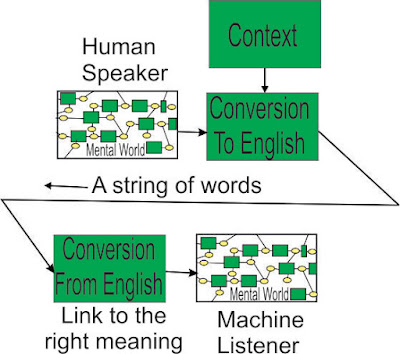Problems to be Handled by Active Structure
For a technical paper, we have been trying to define the problems we are interested in handling:
Some examples:
Climate Change
– a problem which is large and looming. The current data does not reflect the
scale of the problem, and instead one or more climate models need to be used to
estimate the scope of the problem over many years. There are many
cross-specialties – atmospheric modelling, oceanographic modelling, agriculture
in a changing climate, natural disasters.
Complex
Specifications – a specification for a complex piece of technology can run
to a thousand pages, have a glossary and terms defined inline, and be full of
bullets referencing other bullets within clauses. In other words, a description
that is hard to understand, even by experts. It will typically have multiple
areas of expertise – for a plane, that might be wings, fuselage, engines,
control surfaces, avionics. If the technology is “new”, there is no body of
text to support it.
Complex
Legislation – similar to a complex specification, but with an important
increase in complexity. It will often reference the psychological state of the
person whose actions it seeks to control.
Anti-Money
Laundering – a problem where large and cumbersome organizations (banks) are
being used for criminal purposes by intelligent adversaries. A bank can see
only a small part of a money launderer’s activities, and many techniques are
used to conceal those activities, including false accounts, smurfing, false
invoicing, up to infiltration of the bank’s staff. The money launderer can
rapidly change strategy, and use the bank’s size against it.
A Rerun of Covid
– Covid illustrated the difficulty of getting advice from experts as far apart
as epidemiologists and economists, who have no common vocabulary, A machine
that can read and “understand” and integrate text from different specialists
would have been useful to bridge the gap
Strategic
Planning – an obvious example is the changeover from Internal Combustion
Engine (ICE) cars to electric cars (EVs). The timeframe is long, there is
resistance from the public, a legislated timeframe for the transition, after which ICE cars will not be sold,
scarcity of the minerals needed, parallel production of ICE and EVs, an
eventual large reduction in the auto manufacturers’ workforce. Alternative
technologies – solid state batteries, hydrogen fuel cells – may emerge during
the transition, so planning needs to be dynamic and easily reorganized over a
long period of time.
Content Mediation – Social media content is often
spun around some new and newsworthy event, meaning that mediation cannot rely
on a large block of text as input data to make sense of the social media post. Instead,
it is necessary to analyze the post based on the meanings of the words, that
is, at a micro level, with some foreknowledge about political trends and
sarcasm.
Economic
Modelling – “Economics is less amenable than physics
to definitive mathematical analysis because it is about people, whose responses
to similar phenomena change over time. We build models in our minds or
computers that fit observed reality at one point in time, and reality changes.
Then we have to think harder about what’s going on.” – Ross Garnaut.
The recent indecision in the US over whether the surge in inflation
would be transitory or long-lasting illustrated the fragility and poor
predictive power of economic models that do not merge psychology with more mathematical
forms of modelling.
A problem related to those above (all of them would use it) – Semantic Searching. The ability to
create a small piece of text describing precisely what you are looking for and
have it search through potentially millions of Google hits using the meanings
of words.
A problem that
demonstrates the temporary hack of the human cognitive system in response to a
textual command – Lane Following. Modelled problems will require a similar facility when exploring different strategies.
People can describe
much more complex situations in English than in a contrived language, because
English has had to include all the ways of describing the natural world, the
world of human artifacts, and the mental world. Its main strength is that most
of the processing of it is done unconsciously.



Comments
Post a Comment